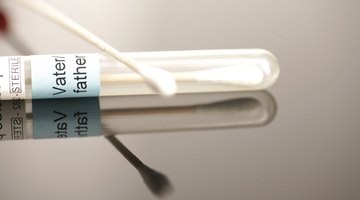What Determines the Gender of a Baby?
Preparing for pregnancy is an exciting process for a couple.
Though any healthy child is a welcome addition to a new family, parents may be secretly hoping for a bundle of joy in pink or blue. Though science indicates that parents have a limited chance of conceiving their preferred gender, hopeful couples can have fun exploring the options while they try for the girl or boy of their dreams.
Father Figures
A baby's gender is always determined by his father, whose sperm carries both X and Y chromosomes. The sperm itself carries only one chromosome, and the sperm carrying the female X chromosome are known to be slower than those carrying the male Y chromosome.
Depending upon the chromosome supplied by the sperm, a boy or girl will result.
According to Harvard Health Publications, sperm of either type are roughly equal in number, so X and Y-chromosome bearing sperm have an equal chance of fertilizing the egg. Therefore, a couple has an estimated 50-50 chance of having a girl or a boy.
Natural Gender Selection Methods

When Does a Baby Develop Gender?
Learn More
Natural gender selection methods have yet to conclusively prove themselves to science, but many couples swear by them. The Shettles method is perhaps the best known, and is based upon the speed of the father's sperm in conjunction with the mother's ovulation cycle.
Because Y-chromosome sperm are faster and do not live as long, couples wishing for a boy should have intercourse as close to ovulation as possible. Another method, the Whelan method, indicates that in order to conceive a boy, the couple needs to have intercourse four to six days before the woman ovulates. For a girl, the couple would have intercourse two or three days before ovulation. The Whelan method is based on the theory that biomechanical changes in the woman's body at certain times of the month make conditions favorable for sperm equipped with a Y or X-bearing chromosome, according to What to Expect. The method has drawn criticism, however, as sperm released six days before ovulation will not live long enough to fertilize an egg.
Gender and Diet
A woman's pre-pregnancy diet may determine the baby's gender, according to Andrew Weill, MD. Women had a slightly bigger chance of conceiving a boy if they consumed a high-calorie diet before becoming pregnant. This may be a result of greater nutrients being absorbed into the woman's body, creating ideal conditions for sperm bearing the Y-chromosome. Scientists involved in a 2008 study at the University of Exeter reasoned that in the animal kingdom, males are born to females with abundant nutrition resources and that the same may hold true for humans. Though a high-calorie pre-pregnancy diet may favor a male baby, Dr. Weill asserts that the margin is very small and the couple's chances of conceiving a preferred gender are still only 50-50.
Other Scientific Methods

Is There a Special Diet for Conceiving a Girl?
Learn More
For couples needing help to conceive, there are some costly, controversial methods of gender determination.
Sperm sorting and preimplantation genetic diagnosis can be used to determine a child's gender, but they are not primarily used for this reason. These methods are primarily for testing embryos and sperm for pre-determined genetic conditions that are undesirable.









